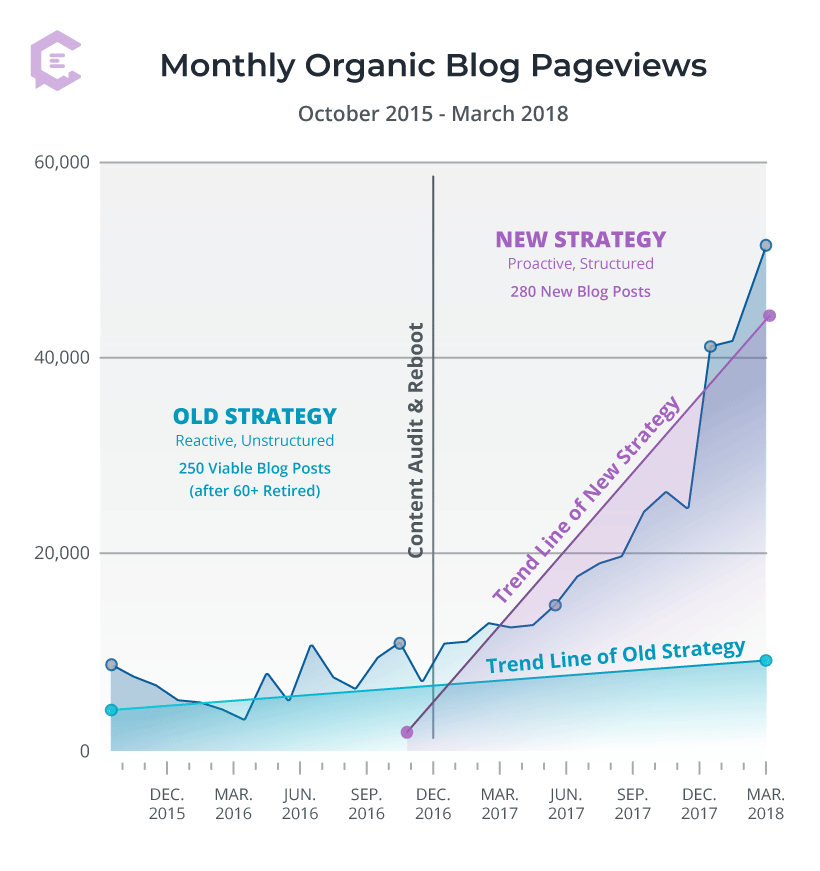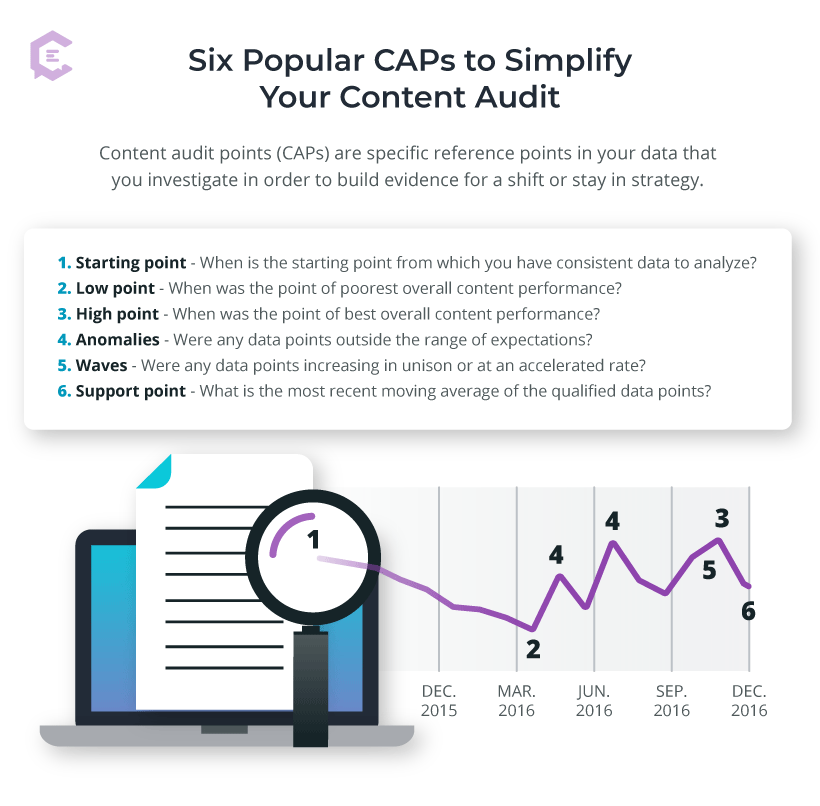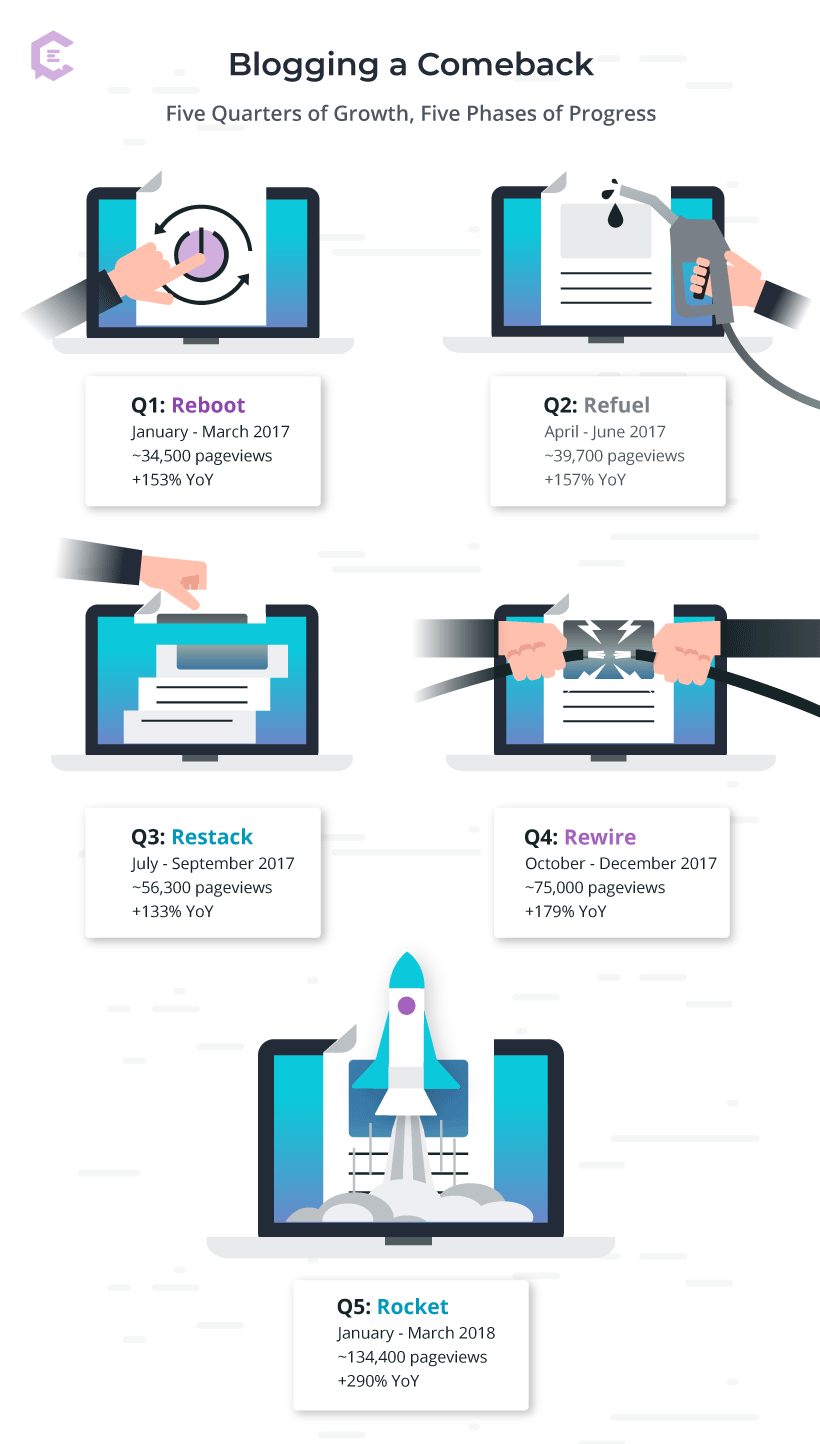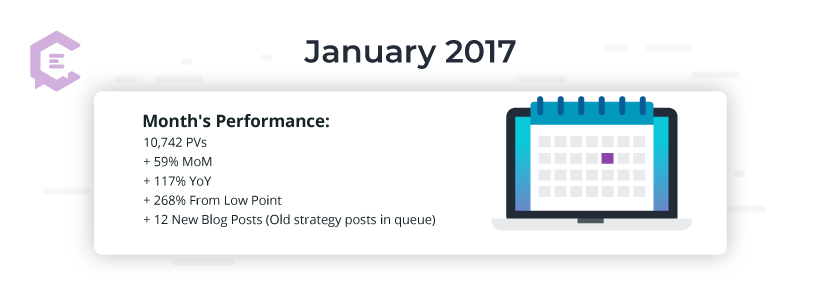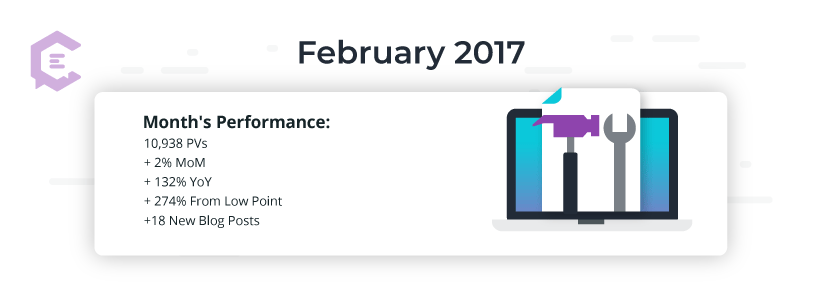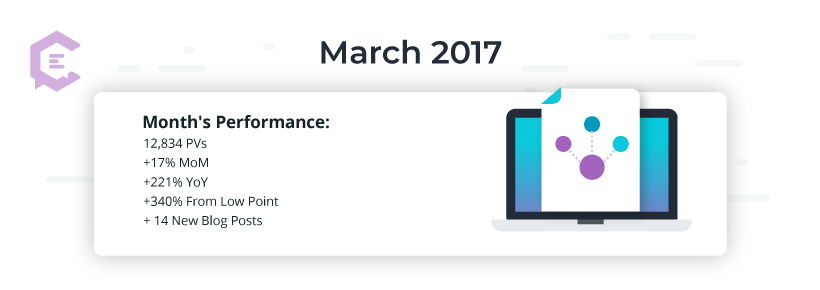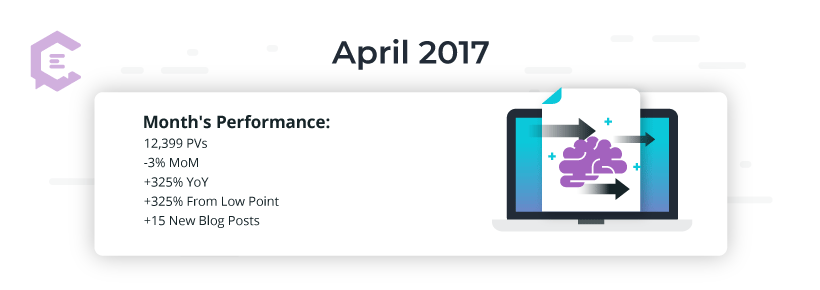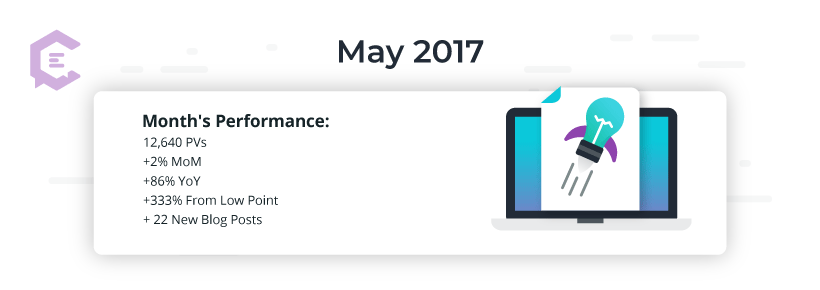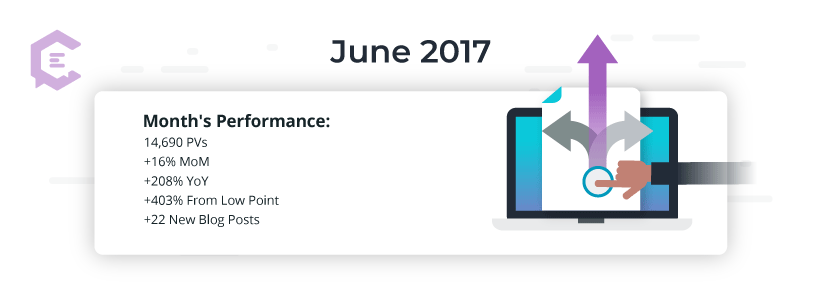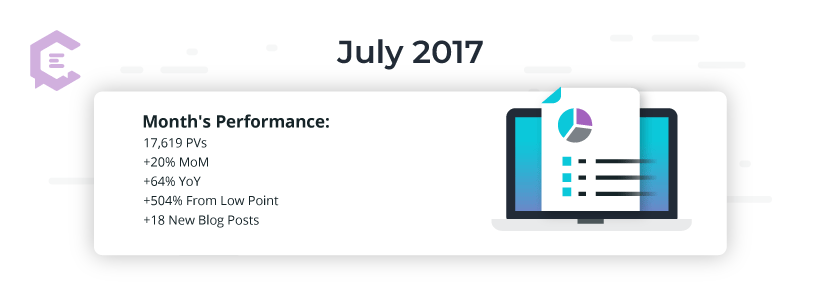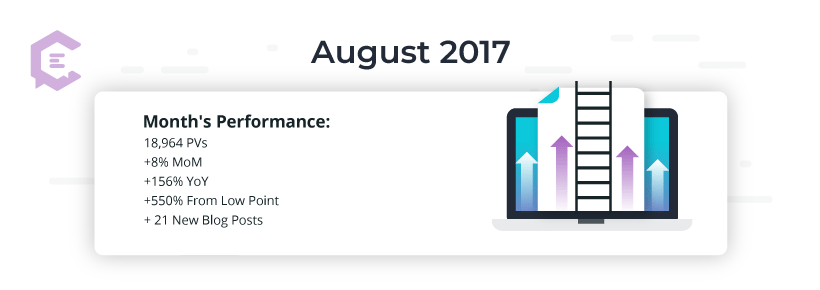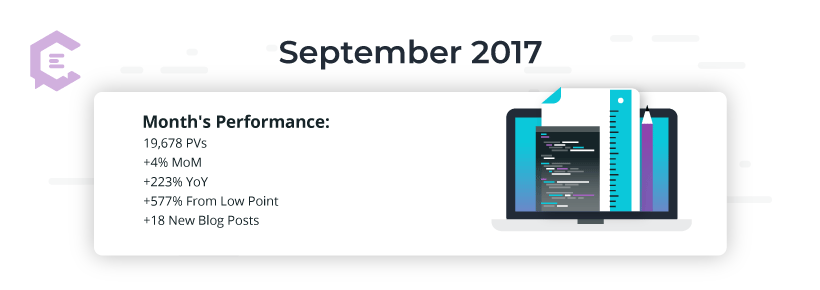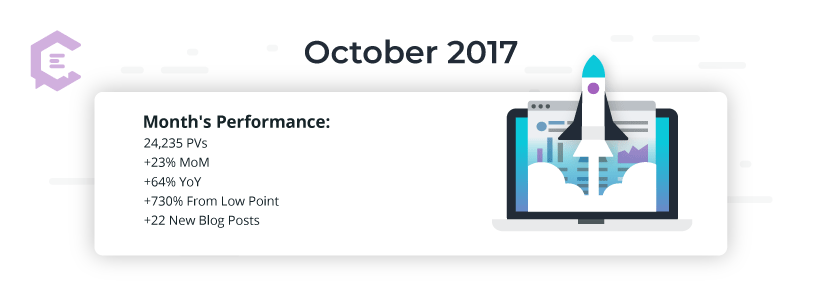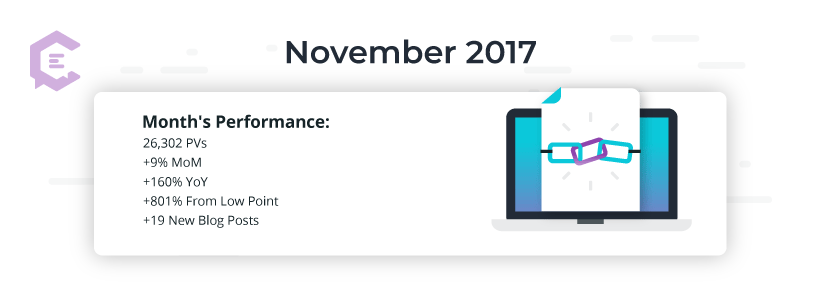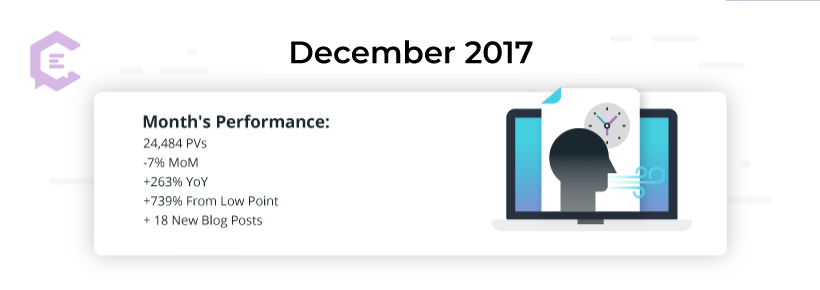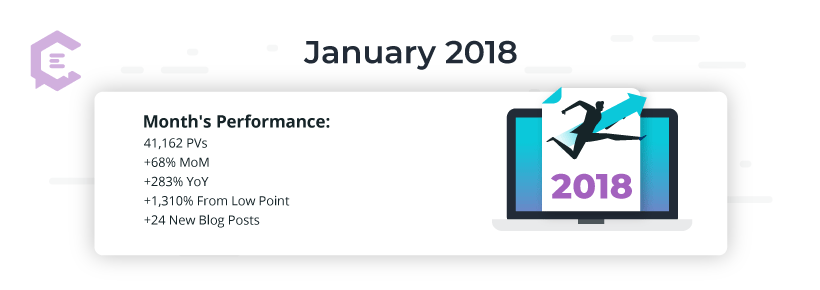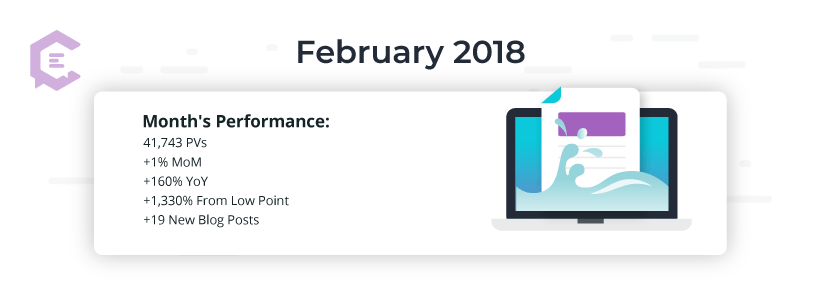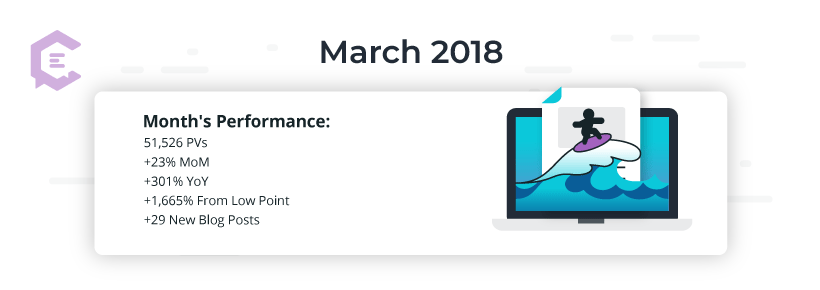We’d like to thank the Content Marketing Institute for selecting this post as a 2019 Content Marketing Award Finalist for “Best Blog Post” and the ClearVoice Blog as a 2019 Content Marketing Award Finalist for “Best Multi-Author Blog.” See other finalists in our good company here.
Want to know how to grow b2b blog traffic? Here’s one case study — our own — to help you get more perspective on planning to win for the long term.
Real numbers. Real strategies. Real timelines. We know it’s what most marketers want to see when it comes to amping up their content game. So we’re sharing ours. No hype. No gimmicks. No paid campaigns. Just honest progress on how we grew our organic blog traffic from 3K to 50K+ pageviews per month. And we’re not done yet.
Want to grow blog traffic? Rethink. Reboot. Rebound.
No matter how established your B2B blog may be, any blog can hit a plateau that no longer satisfies your marketing needs or worse — that no longer drives the aspirations of your brand. And this is what happened to the ClearVoice blog in 2016.
After a two-year stretch of ramping up from scratch, the blog hit a creative drought, a veritable sophomore slump. Traffic had slid faster than a Canadian bobsledder, for six months. Attempts to jolt it back to life with socially targeted content had little lasting effect, like Tesla coils with nary a spark. And although there was a repertoire of successful ebooks, webinars and content magnets to keep the leads coming in, the blog was not living up to its potential… still just a padawan.
The approach to the content needed to change — and that’s when I joined ClearVoice to get things moving upward. So I undertook an audit, laid out the blunt facts, addressed oversights, and adapted the blog strategy to align with the needs of a brand with massive potential. I focused on long plays, not fleeting wins or subscriber gimmicks like those hawked by click-baiting whiteboard-video bros — and it resulted in a striking comeback that is still in the making.
In this case study, I’ll share how we increased our monthly organic blog traffic 1,665%, from ~2,900 monthly pageviews at our low point to ~51,500 sustainable monthly pageviews (and still growing). I’ll review several of the key highlights from our content audit as well as a month-by-month progress report on our content strategy reboot.
My goal is to share the most helpful concepts and strategies to build long-term value, because we don’t just believe — we know — there is no such thing as an overnight success.
Before moving forward, we had to look back at the old content strategy… with content audit points.
Without context, data means nothing. So the purpose of a content audit is to look for patterns and context in your content metrics that could indicate or match patterns in your content quality, optimization or distribution. Although some marketers can get lost in data overload at this point and overanalyze competitors (instead of thoroughly examining themselves), I took a much simpler approach, with content audit points.
Focusing on content audit points (CAPs) for a particular metric, instead of broad data, can help you flush out qualitative issues that might otherwise go unnoticed. CAPs are specific reference points in your data that you investigate in order to build evidence for a shift or stay in strategy. They’re especially helpful if you have multiple channels or long-term data (and lots of it), or need to contextualize engagement (like building a case) for “numbers people” who happen to wrap themselves in spreadsheets (as if they were made of Egyptian cotton).
Although the number and kind of CAPs may vary depending on your content, here are six of the multiple CAPs I applied to our blog data:
CAP #1: The starting point
Choosing the start date: Due to a realignment of our analytics in September 2015, I chose October 2015 as our starting point because prior data would be more subject to inconsistent or false comparisons.
Selecting a primary metric: Because we don’t employ any pageview-churning gimmicks like slideshows or subscriber click-bait that would skew data, I found pageviews to be more telling of engagement and user flow than site visitors alone. I chose monthly pageviews for the sake of simplicity for this case study, but also audited weekly and daily levels (with CAPs for other metrics).
Reviewing an early win: In my analysis of the starting point data, I discovered one blog post, “I Spent $30,000 Testing Different Blog Designs – Here’s What I Found,” accounted for a whopping 63% of total organic blog traffic in October 2015. It wasn’t necessarily a good thing.
CAP #2: The low point
Seeing when we hit bottom: From the starting point in October 2015, blog traffic steadily dropped 66% to the low point in April 2016, which only garnered ~2,900 pageviews. The six-month slide was very telling of the old strategy’s failings.
Reviewing how traffic flow changed: At the low point, referral and direct traffic had plummeted 79% from the starting point. Although search traffic nearly doubled in that same time frame, it was far too small to counter that huge overall decline. It was clear the old strategy lacked layers.
Investigating the primary cause(s): The traffic decay of the top blog post in October mirrored the steady decline, and when its traffic evaporated by April so did most of the overall blog traffic. Only 4% of the top blog post’s traffic was from organic search, so its level of referral and direct traffic was not sustainable for the long term.
CAP #3: The high point
Seeing when we rocked the most: During the audit time frame, the highest blog traffic occurred in November 2016, but by just a smidge more than a previous peak in July 2016.
Reviewing how traffic flow changed: At the starting point, 77% of blog traffic came from referral or direct sources, with only 7% from search. At the high point, traffic from search had risen significantly to 28%. Total traffic at the high point was 27% higher than total traffic at the starting point as well. Something good was starting to rumble under the surface.
Investigating the primary cause(s): For the first time in the 15 months analyzed in the audit, a traffic peak was not caused by a single post, but by a set of five competitive posts comprising 47% of the traffic — a noticeable shift in the traffic patterns. They provided the best examples of the kinds of audience engagement that were working.
CAP #4: The anomalies
Identifying unexpected or outlying data: Recognizing anomalies in our data was vital for accurate analysis. I determined two traffic spikes in May 2016 and July 2016 that looked like outliers.
Investigating the first anomaly: In May 2016, I determined a single blog post accounted for 30% of total blog traffic. It was a non-marketing post picked up by a coding forum for engineers, and only had a temporary traffic spike. It had nothing to do with our company’s core offerings or mission.
Investigating the second anomaly: In July 2016, we published our first major data study, which was on sentiment analysis of 147,000 posts about the 2016 presidential election. The post accounted for 58% of total blog traffic for the month (with a little overlap in August), but quickly flatlined to near-zero traffic by the time of the election. Although it had fleeting success, it was an example of a quick-win mentality overriding sensible, long-term vision.
CAP #5: The wave
Finding our first sign of momentum: From September to December 2016, the five top-performing blog posts (one which was created in October 2015) finally began to show signs of sustainable traffic growth, more than doubling aggregate pageviews in the time period.
Reviewing how the traffic changed: I determined the wave was caused by sustainable growth in organic traffic from search. Our five top-performing posts in terms of SEO accounted for 14% of total blog traffic in September 2016, and grew to 29% of total blog traffic in December 2016. This proved to be a strategic starting point for optimization in the new strategy: to accelerate any discovered momentum.
CAP #6: The support point
Understanding the support point: Similar to a moving average used in stock price analysis, the support point removes anomalies and noise to help determine the metric level that is most likely to be sustainable based on current trends. It can offer a more realistic perspective on performance when making projections and setting goals.
Setting our support point: In determining our support, I purged identified anomalies and assessed data in the six months prior to the actual time of the audit (January 2017). Our support point was 6,550 monthly pageviews, which was ~2,000 pageviews below the moving average that included anomalies. Quite a difference!
Reviewing the true support: The support point showed us sustainable traffic (although improving from a low in April 2016) was still 24% below our starting point — a sign I had to make immediate changes to the existing strategy.
Let’s review a summary of the good — and the “Meh!” — found in our full content audit…
After I completed the full content audit, I prepared the team for a reality check — and we needed one. To grow, you have to be open to analysis and criticism. There is no virtue in the status quo. And there is no shame in admitting your company’s needs have changed.
As I reminded my bosses…
So we’re not afraid to share some of the highlights from the audit summary, as they helped us change and grow.
Some of the best:
- Top-performing posts were those with original data studies or infographics.
- Content catering toward freelance writers possessed far more wit and originality than content catering to brands and marketers. Megan Krause nailed it.
- There were multiple blog posts that had potential to become pillars, if they were tied into a long-term strategy and updated. Others started to show traction from search.
- Ebooks and other gated content were superior to content in the blog, with greater potential to be adapted for traffic growth in the blog.
Some of the worst:
- Too many posts had generic content for broad keywords and topics, without specific or original content that was in sync with the brand trajectory or trends.
- Search optimization on the posts was neither consistent nor current, with far too many missed opportunities. The word length of posts was far below the optimal length for high search rankings. There was no structure or cluster-building.
- From looking at the data, it seemed the content strategy was too reactive and focused on social wins instead of building long-term success, the opposite of what was needed for the brand. There seemed to be a lack of consistent planning. No long-term scaffolding.
- The blog design was off-brand and outdated, with several UI flaws that inhibited engagement — the strategic needs had outgrown the existing framework.
Setting new content strategies, new principles to make our content more valuable… and to grow our blog traffic.
With my content audit complete, I developed a new strategy to address the areas in which we needed the most improvement. After committing to a much-needed website redesign (which would take months to complete), we followed three core principles in redirecting our blog content and tactics:
1. Be more informative.
Instead of tackling topics in broad strokes, educate with specifics.
- Provide more guides and actionable items in content.
- Make topics more specific, timely and in-depth, without filler.
- Integrate more real examples, timely sources and data.
2. Be more original.
Instead of following industry noise, create more authentic content and unique assets.
- Initiate original data studies so our brand can be a primary source.
- Interview more professional creatives to achieve more authentic content.
- Create more original visuals and move away from stock imagery.
- Integrate more forward-thinking content series.
- Stop the over-meme-ing. Seriously.
3. Be more consistent.
Instead of working ad hoc and reactively, plan with systematic purpose, structure, and foresight.
- Plan the calendar much further out and increase post frequency.
- Create recurring content franchises to increase efficiency and build momentum.
- Optimize content in more structured, deliberate ways for long-term gains.
- Build more robust content packages/clusters and fewer one-offs.
- Follow the Time Flow Method to better plan and organize content.
The new content strategy to grow our blog traffic: five quarters, five phases of progress
Too many brands sabotage their blogging efforts by giving up too soon, getting caught up in quick wins instead of lasting returns. We know that blogging is a long-term play, so we expected the payoff wouldn’t be overnight. It would be a planned process driven by our new principles.
To give you a better sense of the pacing of a new strategy, following is exactly what we did and when, month by month. But please note that our efforts were based on our brand’s particular needs, resources and timeline — and these summaries only capture highlights. Yours may be different.
January 2017 – Reboot Phase – Remapping the calendar
We initiated the new content strategy by cleaning house and remapping the content calendar. It wasn’t glamorous. It was necessary grunt work. We had to kill content that was just bad and ensure we had consistent messaging and optimization at the basic level across all posts. We spent considerable time evaluating older posts and rethinking themes and topics to better fit a long-term strategy.
Starting tasks for the month:
- Reading through all existing posts and determining 250 were viable
- Deleting 30+ old posts that had no value in terms of traffic, content, linking or URL keywords; redirecting traffic on other posts that were just “Meh!”
- Optimizing meta descriptions, SEO titles, headers and links on 200+ posts
- Brainstorming new concepts for the immediate and long-term content calendar
- Redirecting assignments and reaching out to freelancers in our Talent Network
- Creating an editorial foresight calendar for our target audiences
February 2017 – Reboot Phase – Restructuring our content
Better structuring of our content and the calendar was essential in making the blog more consistent — and our process more efficient. We launched our first weekly franchises to anchor the calendar for the long term with two complementary themes for our core audience.
Aside from stabilizing our blog traffic, the franchises also had an immediate impact on reducing our time spent brainstorming ideas – by a couple hours per week – as the writers took more ownership of the content.
Martech Monday by Ben Beck
Expert content that has longer-term/instructional value. We developed Martech Monday to help our marketing audience, and ourselves too, keep on top of the rapidly changing landscape of digital marketing tools. Ben Beck’s easy-to-follow how-tos and reviews continue to build traffic, including one of his first comparison posts in the franchise: Piktochart vs Canva vs Visme: We Put 3 Visual Storytelling Tools to the Test.
Content Radar by Chad Buleen
Curated, timely content that has shorter-term/action value. As a counter-balance to Martech Monday, we developed the weekly Content Radar to help our audience cut through the noise. Every Wednesday, Chad Buleen rounds up important updates in content marketing that might have more immediate effects on how marketers and creatives approach their content and promotion, such as How Gmail’s Facelift Will Affect Your Email Marketing Efforts.
March 2017 – Reboot Phase – Aligning new content
By March, our new efforts were just starting to take effect. Search traffic had jumped to the highest since the blog’s inception. After making rounds of assignments in January and February, we were able to publish our first posts supporting two key structural strategies: content series and expert pools.
Content series: Your Brand’s Vision and Mission
Series written by Britt Skrabanek, Stacy Jackson and Gregg Rosenzweig.
Our first content series, which was a five-part topic cluste, focused on the starting point for any content marketing: your brand’s vision and mission. To lead it off, we interviewed Jenna Briand and Miriam Bookey, two brilliant agency chiefs at Redbird who value authenticity and the human narrative behind all good content – a philosophy we’ve also embraced at ClearVoice.
The logical order of the posts followed our Thought-Example-Action model of content structure, which could be applied to many topics.
- Post 1: Get insights from two agency chiefs.
- Post 2: Create your content vision.
- Post 3: Apply your vision to content philosophy.
Expert interview: Brodie Smith
To satisfy two of our core principles behind our content strategy – being more informative and more original – we strove to broaden our base of interviews with experts and content creators outside the traditional marketing echo chamber. Enter Brodie Smith, an Ultimate Frisbee star who has made significant success as an influencer with 1,000,000+ followers, in A Crash Course in Influencer Marketing With Brodie Smith, by Gregg Rosenzweig.
April 2017 – Refuel Phase – Thinking further ahead
Although traffic dipped ever so slightly, it stayed the course – a great example of when a plateau is a good thing. We became confident the new strategy had tempered the unpredictable swings of the old strategy. With this in mind, we began executing our first data studies in the background (which would take months of production) and focused on other major projects with long-term value:
Creating more content series: Outside of our weekly franchises, we continued to assign more blog posts that fit into long-term content series, some of which would take months to complete based on our posting frequency of three posts per week (although that frequency would soon change).
Prepping the website redesign: Although our new website wouldn’t launch until late October, we started aligning goals and messaging for all the pages of the new site and blog resources – which would inform blog content planning. If your brand has been through a website redesign, you know how much of your resources it can suck up, like a hurricane of crossfire. And in our case, it was no different, which made the new content strategy even more important. The long-term structural approach proved to be a smooth arc over which our content could glide during the transition.
May 2017 – Refuel Phase – Accelerating new initiatives
After a mini content audit, we were confident the new strategy was working as expected. We had achieved our first goal: three consecutive months with traffic at least 50% higher than the support point (6,550 pvs at the full content audit). So we increased our posting frequency from an average of three posts per week to five posts per week to reach our next goal faster (doubling the support point).
We filled most of the new calendar openings with posts fulfilling two strategies:
- Optimization refreshes: As part of our long-term SEO strategy, we assigned expansions and refreshes to existing posts that had potential to be pillar posts, based on traffic trends and competitive analysis. One example includes a post (by one of our favorite contributors, Stacy Jackson) that became a pillar after two periodic refreshes: 25 Questions to Ask When Building a Content Creation Strategy.
- Thought pieces: Not to be confused with “thought leadership,” a phrase that’s thrown about far too often by self-aggrandizing execs, our “thought pieces” are intended to help push the readers’ thinking beyond the everyday noise. We’ve included interviews with Hollywood creatives to independent professionals, but started in-house with an original approach to content planning that we guarantee you’ve never heard of before, but have experienced without knowing it: Turning Time Into a ‘How’: Using the Time Flow Method.
June 2017 – Refuel Phase – Hitting the turning point
In June, we surpassed our second goal, which was doubling the traffic of our support point at the time of the content audit. And we achieved it with sustainable traffic, primarily from search, sans any anomalies. Increasing our posting frequency already had made a positive impact. Looking back, June was a clear turning point in terms of the upward trend of traffic.
Here are two of the most popular posts originally published this month that have continued to build traffic since:
Top 30 Content Creation Tools for Freelancers and Marketers
One of our most popular listicles, Martech expert Ben Beck’s roundup of content creation tools has been updated periodically, boosting traffic higher from search with each iteration.
Content Marketing for Education and Nonprofits: Best Practices
To introduce to our ebook, Content Marketing Best Practices: Higher Education & Nonprofits, we had a niche expert who has directed programs for international nonprofits write a complementary post to contextualize the value of our content. By Elizabeth Chey.
July 2017 – Restack Phase – Bringing on the data studies
We published our first of multiple new data studies, which were significant link-earners. Efforts from our search optimization sweeps earlier in the year were noticeably starting to pay off, and the increase in posting frequency showed signs of boosting overall traffic. Our primary strategy was to build long-term search traffic and not short-term social traffic, and it was working.
Still one of our most popular data studies:
The Power of Pay for Travel Writers
Freelance rates vs. quality: Do you get what you pay for? We assigned one travel article to seven writers and had 30 editorial pros rate the submissions based on the over quality of the writing, ability to follow guidelines, and number of errors. Did experts outperform beginner writers? See the results. By Allie Gray Freeland.
August 2017 – Restack Phase – Building the next tier of ladders
Now that the first content created for the new strategy was hitting the six-month mark, it was an ideal time to start building the next tiers on our content ladders. We published the second of our data studies and a series of optimization updates and expansions to existing blog posts in content series. An August refresh to our inaugural content series (which was published in March) started to show compounded traffic growth as well.
Among several content series (aka content ladders), we launched our inaugural post in our series on interviewing, a crucial and in-demand skill that separates good writers from bad ones:
Tasked with a new or challenging freelance assignment? Sharpen your interviewing skills to write like an expert on anything. Get a journalist’s tips on how to interview experts, influencers and leaders — with a few pointers gleaned from Neil deGrasse Tyson. By Elizabeth Chey.
September 2017 – Restack Phase – Prepping for the new website
In September, we hit another goal: tripling our support point. We began publishing posts to align with a 40-post guide on a core audience topic while bringing in an additional, fresh group of freelancers who specialized in interviewing sources. We also spent considerable time repurposing content to fulfill needs of our upcoming website redesign in October, including:
- Overhauling our blog taxonomy and retagging all posts to align with new pages
- Creating 30+ resource pages for existing assets no longer gated
- Reformatting our Content Radar franchise to go more in-depth on singular topics
October 2017 – Rewire Phase – Launching the new website
At the end of the month, we launched our completely redesigned website (and, damn, it sparkles now), including significant UI and technical updates, such as making pageloads 6x faster. We also redirected our design strategy with original illustrations for our blog posts that brought more visual narratives and creativity to our content.
Some of the posts from October that are still building in popularity:
15 Scenarios When to Pay Freelance Writers Higher Rates
Respecting freelancers’ time and value is key to a good working relationship. Learn when you should reasonably expect to pay freelance writers more than a standard rate — so you don’t drive away good talent. By Allie Gray Freeland.
What Kind of Freelance Editor Do I Need?
Just like writers, not all editors are the same. Read a pro’s savvy rundown on the types of freelance editors you might need for various content projects. Learn the differences between developmental editing, manuscript evaluation, line editing, copy editing, proofreading, and book shepherding. By Jenna Rose Robbins.
November 2017 – Rewire Phase – Linking like never before
We spent most of November optimizing all existing blog posts for the new website structure, which included manually redoing our internal linking strategy from scratch… We’re talking thousands of links in 400+ blog posts…. manually.
We also launched our third content franchise, The Niche Freelancer by Lena Katz, as part of our mission to help brands find better voices for their content.
Popular posts from November:
The Niche Freelancer: What It Takes to Be a Tech Writer
Freelance tech writers are in high demand. Learn what it takes to be a great one in our Q&A with Erik Sherman, an expert business and technology writer who’s written for The Wall Street Journal, Fortune, Forbes, Inc., and other top publications. By Lena Katz.
Survey Results: Factors for Determining Freelance Rates for Different Assignments
Get survey results and a full-time freelancer’s breakdown on how time, tasks and experience can affect the rates freelance writers charge for different assignments. Consider factors like research, surveys, image requests, finding interview sources and more. By Jenna Rose Robbins.
December 2017 – Rewire Phase – Waiting to exhale
Wait for it… Wait for it… Although people not attuned to content would expect an immediate bonanza after a website re-launch, it’s not uncommon for a dip in traffic as page flows change, site behaviors readjust and search indices catch up. So our holiday dip was not a surprise, especially considering Google had thrown yet another wrench into SEO with the doubling of the character limit on meta descriptions from 165 to 320 characters. We zipped to rewriting 200+ meta descriptions on posts (to test a hunch of longer descriptions and click-through rates). [Note: Google has since changed course again on meta descriptions. Regardless, our exercise helped articulate better promos for our content onsite and offsite as well.] The big payoff was about to come.
We ended the year with a major study, “What’s Your Biggest Challenge With Content?”, which has become a highly valuable asset, and more posts focusing on the craft of content:
What’s Your Biggest Challenge With Content?
We asked 1,000 marketers seeking help with their content marketing one simple question: “What’s your biggest challenge with content?” No multiple-choice selections. Just an open-ended invitation to reply — and to allow us to listen. Discover the top 35 challenges broken down by category and other key insights. By Justin McKinley.
Crafting Engaging Press Releases That Catch the Attention of Curiosity Rovers
Posting on social media is not enough. With so many niche audiences within the media landscape, companies wanting a press release to go from pitch to press should mind who they are writing for. A reporter who has reviewed thousands of press releases offers tips to improve media pickup for your next press launch. By Elizabeth Chey.
January 2018 – Rocket Phase – Leaping into the new year
Exhale… We experienced a long-awaited leap… Although there were many factors, including lots of earned links from Q4 content, we attribute some of the leap to the website redesign and optimization that finally kicked in to unlock our content’s potential, as traffic from search jumped up significantly across the board. Not to mention, we kept hammering out expert content that was leagues above our competition.
Just a sample of January’s powerhouse lineup that made a lot more people take notice:
- 300+ Events to Jump-Start Your 2018 Editorial Foresight Calendar [Template]
- Survey Results on Millennials’ Social Video Habits: 9 Key Questions Answered
- Here’s How to Land Impressive Interviews That Make Great Content
- Bitcoin, Blockchain, Content Marketing: How They Connect, Why It Matters
- The Niche Freelancer: Stories in Sounds, From NPR to Podcast Producing
February 2018 – Rocket Phase – Making a new wave
We continued to assign posts that fell into our set of content series stacks (which would be rolled into packages, email drips and guides) and that integrated interviews with professional creatives and experts. Our search traffic took noticeable shifts since the January jump, so we initiated our 2018 full content audit… and determined the January pop was not an anomaly, but the start of a new wave.
Some of the February posts that fueled the wave:
- How to Burst the Social Media Bubble With Lookalike Audience Matching
- How the Creator of the ‘Mortified’ Phenom Turned America’s Diaries Into a Global Movement
- Who Scores Better at Being an Editorial Assistant: Alexa or Siri?
March 2018 – Rocket Phase – Riding the wave higher
Even after coming a year full-circle with the new strategy, traffic in March continued to accelerate with a 23% pop — and has not turned back since. So we pushed our efforts further: We started publishing half-length blog posts (~600 words in length) on Saturdays and Sundays, a test we ran for the entire month. Traffic from search increased 22% faster on Sundays than the average weekday during the test.
New posts in March pushing the success higher:
- Behind the Scenes at a ‘Family Guy’ Table-Read
- A Top Talent Recruiter’s Secrets to Perfecting Your Creative Portfolio
- The Freelance Writer’s Guide to Taxes
And we’re not done yet… We have more than 80 freelancers to thank.
So there you have it. How we blogged a comeback. Yet none of our momentum would be possible without the 80+ freelance writers and designers who have contributed their words, edits and imagination to our content, using ClearVoice to grow ClearVoice. And we’re nowhere near done yet.

